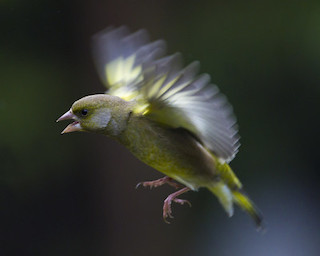 If you feed your garden birds, you probably won’t need to go far to see Greenfinches, a regular garden visitor, on The Lizard.
If you feed your garden birds, you probably won’t need to go far to see Greenfinches, a regular garden visitor, on The Lizard.
Photo: © Natural England/Allan Drewitt
Scientific name: Carduelis chloris
Other common names: Eurasian Greenfinch
 A common bird of woodland, farmland and hedges, and a regular garden visitor, the Greenfinch’s distinctive green-yellow plumage and sociable nature make it a familiar and welcome sight at bird feeders, especially in the winter when they sometimes form mixed, often quarrelsome, flocks with other finches. Similar in size to a House Sparrow, male Greenfinches are more colourful than slightly duller females and juveniles, having more visible yellow in their plumage. Watch out for the yellow wing and tail flashes of the males during their pirouetting courtship flight in the spring.
A common bird of woodland, farmland and hedges, and a regular garden visitor, the Greenfinch’s distinctive green-yellow plumage and sociable nature make it a familiar and welcome sight at bird feeders, especially in the winter when they sometimes form mixed, often quarrelsome, flocks with other finches. Similar in size to a House Sparrow, male Greenfinches are more colourful than slightly duller females and juveniles, having more visible yellow in their plumage. Watch out for the yellow wing and tail flashes of the males during their pirouetting courtship flight in the spring.
Distributed across Europe, northern Africa and southwest Asia, Greenfinches are found throughout the British Isles, numbering over 1.5 million pairs. Numbers increase further south in the winter as some birds migrate from the colder more northern regions of Britain and Scandinavia, but the species is primarily a resident breeder here. A pair can raise two broods per year, with each clutch containing four to five eggs in a nest usually found in evergreen shrubs. Pairs form small loose colonies to breed.
 The Greenfinch can eat various sizes of seeds with its powerful bill, will eat peanuts, and loves sunflower seeds. Their adaptation to gardens is probably a result of a decrease in seed availability on farmland due to changing farming practices.
The Greenfinch can eat various sizes of seeds with its powerful bill, will eat peanuts, and loves sunflower seeds. Their adaptation to gardens is probably a result of a decrease in seed availability on farmland due to changing farming practices.
Although still generally considered a common bird, numbers have more recently been hit by the emergence of a disease (in the mid-2000s), Trichomonosis, caused by the protozoan parasite Trichomonas gallinae. Although it affects other garden bird species, Greenfinches (and Chaffinches) have been particularly badly affected. The parasite cannot be transmitted to humans or mammalian pets.
Did you know…?
…The average lifespan of a Greenfinch is two years, but the oldest recorded age is over 12 years old (from ringing records).
…To help prevent the spread of Trichomonosis, regularly clean bird feeders and tables and rotate the position of feeders in the garden to avoid a build-up of contamination.
More information and references:
Gooders, J. and Harris, A., 1986. Field Guide to the Birds of Britain and Ireland. Kingfisher Books, London.
Robinson, R.A. et al., 2010. Emerging infectious disease leads to rapid population declines of common British birds. PLoS ONE 5(8), e12215 (open access article).
Published: January 2014
Author: Amanda Scott
Photos: © Natural England/Allan Drewitt
